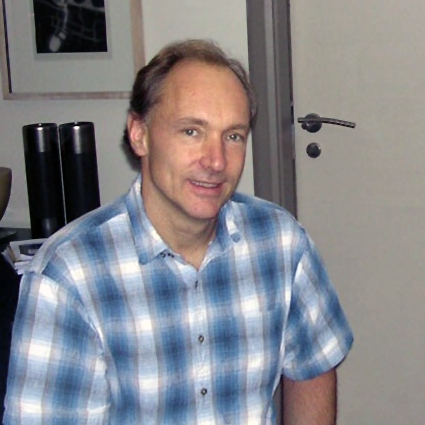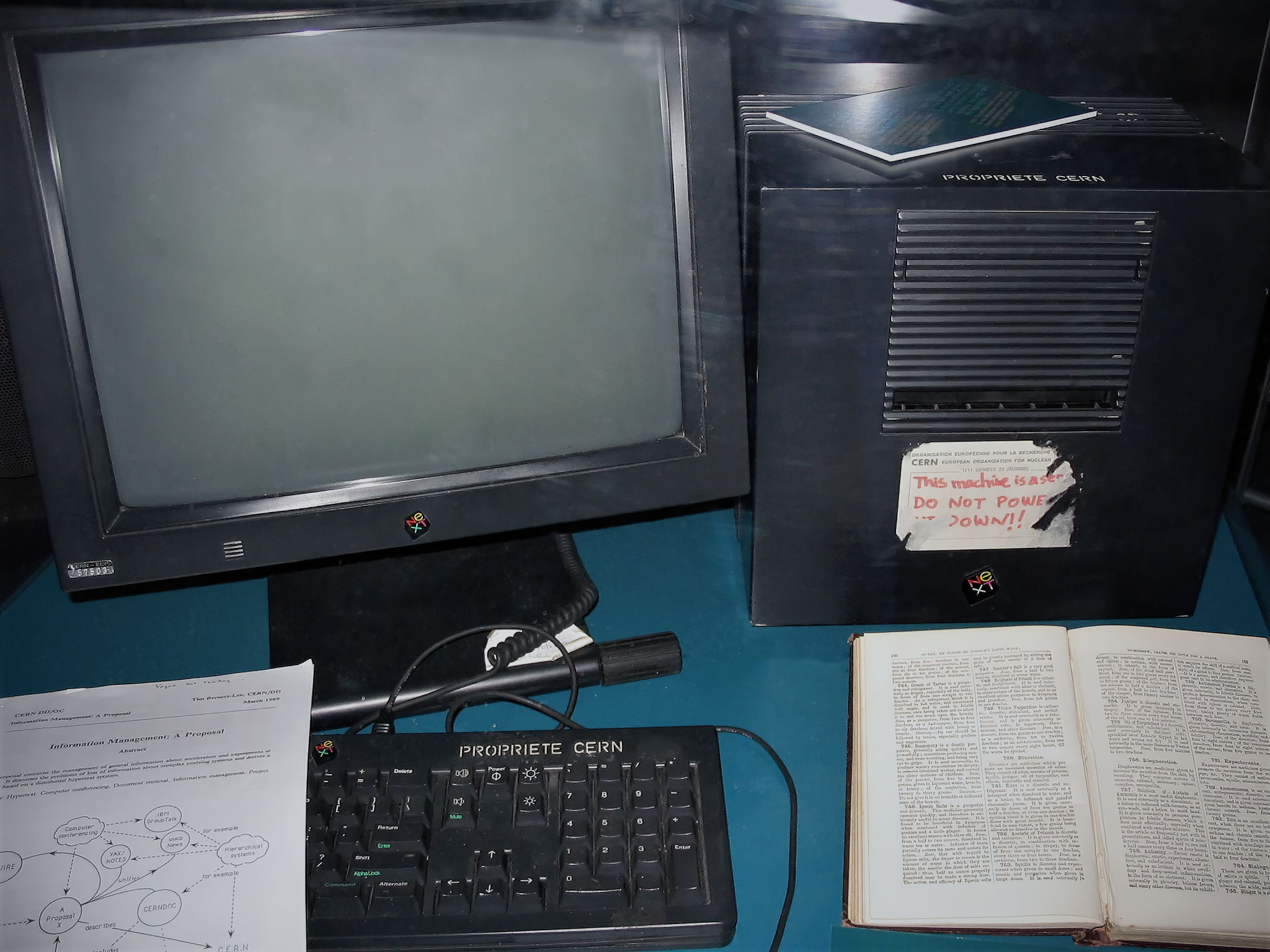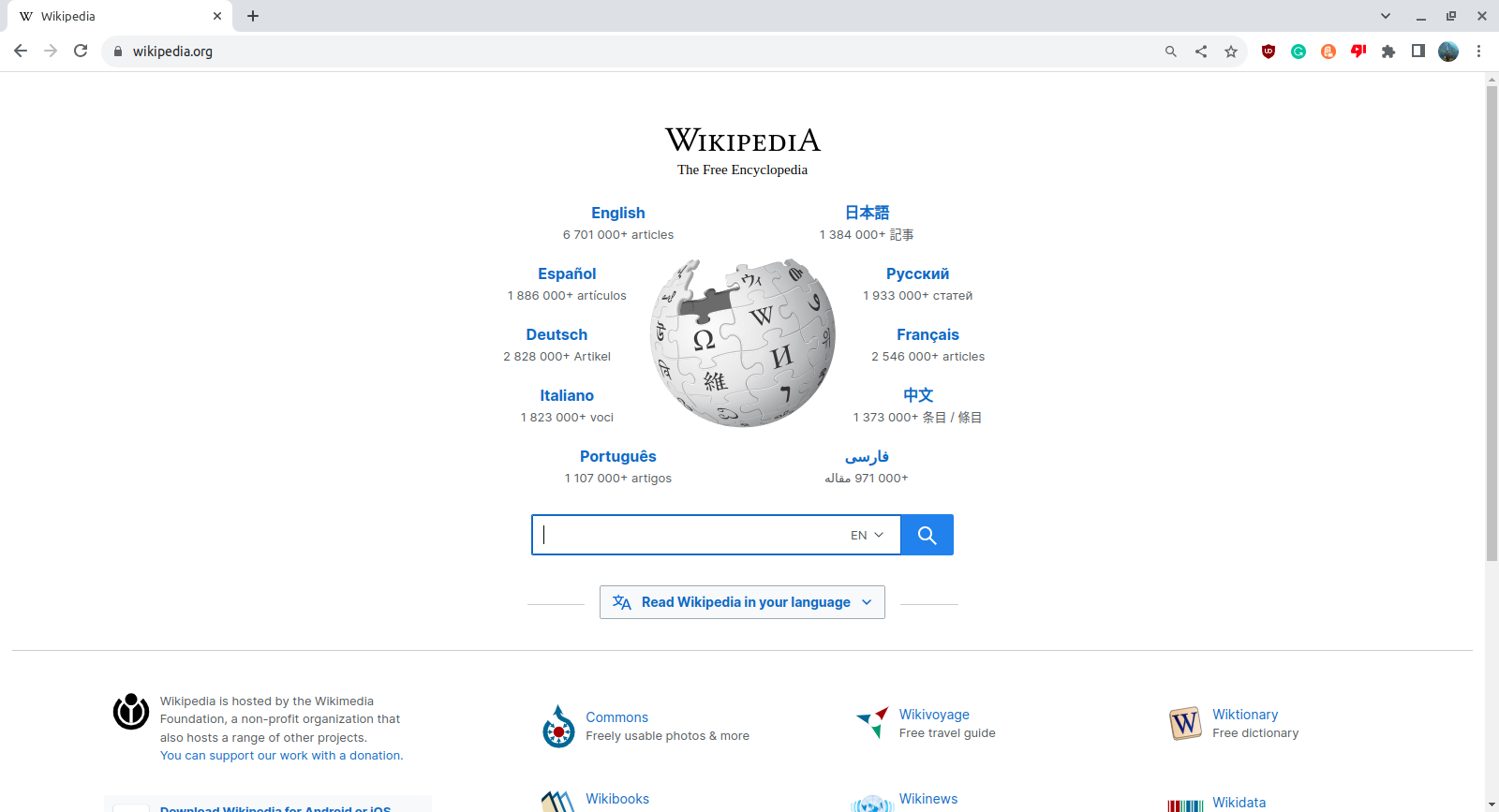|
ENQUIRE
ENQUIRE was a software project written in 1980 by Tim Berners-Lee at CERN, which was the predecessor to the World Wide Web. It was a simple hypertext program that had some of the same ideas as the Web and the Semantic Web but was different in several important ways. According to Berners-Lee, the name was inspired by the title of an old how-to book, '' Enquire Within upon Everything''. The conditions Around 1980, approximately 10,000 people were working at CERN with different hardware, software and individual requirements. Much work was done by email and file exchange, which the scientists used to keep track of different parts of intersecting projects. Berners-Lee started to work for 6 months on 23 June 1980 at CERN, where he developed ENQUIRE as a personal organizational tool. The requirements for setting up a new system were compatibility with different networks, disk formats, data formats, and character encoding schemes, which made any attempt to transfer information betw ... [...More Info...] [...Related Items...] OR: [Wikipedia] [Google] [Baidu] |
Tim Berners-Lee
Sir Timothy John Berners-Lee (born 8 June 1955), also known as TimBL, is an English computer scientist best known as the inventor of the World Wide Web, the HTML markup language, the URL system, and HTTP. He is a professorial research fellow at the University of Oxford and a professor emeritus at the Massachusetts Institute of Technology (MIT). Berners-Lee proposed an information management system on 12 March 1989 and implemented the first successful communication between a Hypertext Transfer Protocol (HTTP) client and Server (computing), server via the Internet in mid-November. He devised and implemented the first Web browser and Web server and helped foster the Web's subsequent development. He is the founder and emeritus director of the World Wide Web Consortium (W3C), which oversees the continued development of the Web. He co-founded (with Rosemary Leith) the World Wide Web Foundation. In April 2009, he was elected as Foreign Associate of the National Academy of Sciences. B ... [...More Info...] [...Related Items...] OR: [Wikipedia] [Google] [Baidu] |
CERN
The European Organization for Nuclear Research, known as CERN (; ; ), is an intergovernmental organization that operates the largest particle physics laboratory in the world. Established in 1954, it is based in Meyrin, western suburb of Geneva, on the France–Switzerland border. It comprises #Member states and budget, 24 member states. Israel, admitted in 2013, is the only full member geographically out of Europe. CERN is an official United Nations General Assembly observers#Intergovernmental organizations, United Nations General Assembly observer. The acronym CERN is also used to refer to the laboratory; in 2023, it had 2,666 scientific, technical, and administrative staff members, and hosted about 12,370 users from institutions in more than 80 countries. In 2016, CERN generated 49 Byte#Multiple-byte units, petabytes of data. CERN's main function is to provide the particle accelerators and other infrastructure needed for high-energy physics research – consequently, numer ... [...More Info...] [...Related Items...] OR: [Wikipedia] [Google] [Baidu] |
Hypertext
Hypertext is E-text, text displayed on a computer display or other electronic devices with references (hyperlinks) to other text that the reader can immediately access. Hypertext documents are interconnected by hyperlinks, which are typically activated by a mouse (computing), mouse click, keypress set, or screen touch. Apart from text, the term "hypertext" is also sometimes used to describe tables, images, and other presentational content formats with integrated hyperlinks. Hypertext is one of the key underlying concepts of the World Wide Web, where Web pages are often written in the Hypertext Markup Language (HTML). As implemented on the Web, hypertext enables the easy-to-use publication of information over the Internet. Etymology The English prefix "hyper-" comes from the Greek language, Greek prefix "ὑπερ-" and means "over" or "beyond"; it has a common origin with the prefix "super-" which comes from Latin. It signifies the overcoming of the previous linear cons ... [...More Info...] [...Related Items...] OR: [Wikipedia] [Google] [Baidu] |
Project Xanadu
Project Xanadu ( ) was the first hypertext project, founded in 1960 by Ted Nelson. Administrators of Project Xanadu have declared it superior to the World Wide Web, with the mission statement: "Today's popular software simulates paper. The World Wide Web (another imitation of paper) trivialises our original hypertext model with one-way ever-breaking links and no management of version or contents." ''Wired'' magazine published an article entitled "The Curse of Xanadu", calling Project Xanadu "the longest-running vaporware story in the history of the computer industry"., archive-url=https://web.archive.org/web/20151026021059/https://www.wired.com/1995/06/xanadu/, archive-date=October 26, 2015, url-status=live The first attempt at implementation began in 1960, but it was not until 1998 that an incomplete implementation was released. A version described as "a working deliverable", OpenXanadu, was made available in 2014. History Nelson's vision was for a "digital repository scheme f ... [...More Info...] [...Related Items...] OR: [Wikipedia] [Google] [Baidu] |
NLS (computer System)
NLS (oN-Line System) was a revolutionary computer collaboration system developed in the 1960s. It was designed by Douglas Engelbart and implemented by researchers at the Augmentation Research Center (ARC) at the SRI International, Stanford Research Institute (SRI). It was the first computer system to employ the practical use of hypertext links, a computer mouse, raster scan, raster-scan computer monitor, video monitors, information organized by relevance, GUI, screen windowing, presentation programs, and other modern computing concepts. It was funded by ARPA (the predecessor to DARPA, Defense Advanced Research Projects Agency), NASA, and the United States Air Force, US Air Force. The NLS was demonstrated in "The Mother of All Demos". Development Douglas Engelbart developed his concepts while supported by the US Air Force from 1959 to 1960 and published a framework in 1962. The strange acronym, NLS (rather than OLS), was an artifact of the evolution of the system. Engelbart's f ... [...More Info...] [...Related Items...] OR: [Wikipedia] [Google] [Baidu] |
Memex
A memex (from "memory expansion") is a hypothetical electromechanical device for interacting with microform documents and described in Vannevar Bush's 1945 article " As We May Think". Bush envisioned the memex as a device in which individuals would compress and store all of their books, records, and communications, "mechanized so that it may be consulted with exceeding speed and flexibility". The individual was supposed to use the memex as an automatic personal filing system, making the memex "an enlarged intimate supplement to his memory".. The concept of the memex influenced the development of early hypertext systems and personal knowledge base software. The hypothetical implementation depicted by Bush for the purpose of concrete illustration was based upon a document bookmark list of static microfilm pages and lacked a true hypertext system, where parts of pages would have internal structure beyond the common textual format. Development An electromechanical memex device I ... [...More Info...] [...Related Items...] OR: [Wikipedia] [Google] [Baidu] |
Enquire Within Upon Everything
''Enquire Within upon Everything'' is a how-to book, akin to a short encyclopedia for domestic life, first published in 1856 by Houlston and Sons of Paternoster Square in London. The editor was Robert Kemp Philp. It was then continuously reprinted in many new and updated editions as additional information and articles were added (and obsolete material sometimes removed). Topics The book was created with the intention of providing encyclopedic information on topics as diverse as etiquette, parlour games, cake recipes, laundry tips, holiday preparation, and first aid: To quote from the editor's introduction: Though not rich in such material, ''Enquire Within'' also provided the basics of an English-usage style guide, and also preserved examples of regional dialect usage (which it tended to mock as faulty). Several editions between the 1880s and 1910s provide one of the only surviving records of the rules of the English version of trucco, a somewhat croquet-like form of ... [...More Info...] [...Related Items...] OR: [Wikipedia] [Google] [Baidu] |
World Wide Web
The World Wide Web (WWW or simply the Web) is an information system that enables Content (media), content sharing over the Internet through user-friendly ways meant to appeal to users beyond Information technology, IT specialists and hobbyists. It allows documents and other web resources to be accessed over the Internet according to specific rules of the HTTP, Hypertext Transfer Protocol (HTTP). The Web was invented by English computer scientist Tim Berners-Lee while at CERN in 1989 and opened to the public in 1993. It was conceived as a "universal linked information system". Documents and other media content are made available to the network through web servers and can be accessed by programs such as web browsers. Servers and resources on the World Wide Web are identified and located through character strings called uniform resource locators (URLs). The original and still very common document type is a web page formatted in Hypertext Markup Language (HTML). This markup lang ... [...More Info...] [...Related Items...] OR: [Wikipedia] [Google] [Baidu] |
Hyperlink
In computing, a hyperlink, or simply a link, is a digital reference providing direct access to Data (computing), data by a user (computing), user's point and click, clicking or touchscreen, tapping. A hyperlink points to a whole document or to a specific element within a document. Hypertext is text with hyperlinks. The text that is linked from is known as anchor text. A software system that is used for viewing and creating hypertext is a ''hypertext system'', and to create a hyperlink is ''to hyperlink'' (or simply ''to link''). A user following hyperlinks is said to ''navigate'' or ''browse'' the hypertext. The document containing a hyperlink is known as its source document. For example, in content from Wikipedia or Google Search, many words and terms in the text are hyperlinked to definitions of those terms. Hyperlinks are often used to implement reference mechanism (engineering), mechanisms such as tables of contents, footnotes, bibliographies, index (publishing), indexes, a ... [...More Info...] [...Related Items...] OR: [Wikipedia] [Google] [Baidu] |
Blog
A blog (a Clipping (morphology), truncation of "weblog") is an informational website consisting of discrete, often informal diary-style text entries also known as posts. Posts are typically displayed in Reverse chronology, reverse chronological order so that the most recent post appears first, at the top of the web page. In the 2000s, blogs were often the work of a single individual, occasionally of a small group, and often covered a single subject or topic. In the 2010s, multi-author blogs (MABs) emerged, featuring the writing of multiple authors and sometimes professionally Editing, edited. MABs from newspapers, other News media, media outlets, universities, think tanks, advocacy groups, and similar institutions account for an increasing quantity of blog Web traffic, traffic. The rise of Twitter and other "microblogging" systems helps integrate MABs and single-author blogs into the news media. ''Blog'' can also be used as a verb, meaning ''to maintain or add content to a blog ... [...More Info...] [...Related Items...] OR: [Wikipedia] [Google] [Baidu] |
Web Site
A website (also written as a web site) is any web page whose content is identified by a common domain name and is published on at least one web server. Websites are typically dedicated to a particular topic or purpose, such as news, education, commerce, entertainment, or social media. Hyperlinking between web pages guides the navigation of the site, which often starts with a home page. The List of most-visited websites, most-visited sites are Google Search, Google, YouTube, and Facebook. All publicly-accessible websites collectively constitute the World Wide Web. There are also private websites that can only be accessed on a intranet, private network, such as a company's internal website for its employees. User (computing), Users can access websites on a range of devices, including desktop computer, desktops, laptops, tablet computer, tablets, and smartphones. The application software, app used on these devices is called a web browser. Background The World Wide Web (WWW) was ... [...More Info...] [...Related Items...] OR: [Wikipedia] [Google] [Baidu] |
Content Management System
A content management system (CMS) is computer software used to manage the creation and modification of digital content ( content management).''Managing Enterprise Content: A Unified Content Strategy''. Ann Rockley, Pamela Kostur, Steve Manning. New Riders, 2003. It is typically used for enterprise content management (ECM) and web content management (WCM). ECM typically supports multiple users in a collaborative environment, by integrating document management, digital asset management, and record retention. Alternatively, WCM is the collaborative authoring for websites and may include text and embed graphics, photos, video, audio, maps, and program code that display content and interact with the user. ECM typically includes a WCM function. Structure A CMS typically has two major components: a content management application (CMA), as the front-end user interface that allows a user, even with limited expertise, to add, modify, and remove content from a website without the interve ... [...More Info...] [...Related Items...] OR: [Wikipedia] [Google] [Baidu] |







